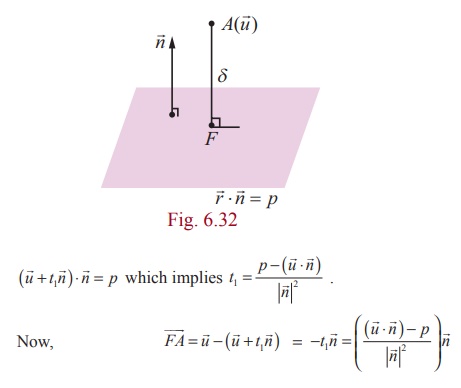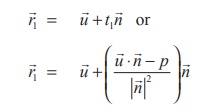Definition, Theorem, Proof, Solved Example Problems, Solution - Distance of a point from a plane | 12th Mathematics : UNIT 6 : Applications of Vector Algebra
Chapter: 12th Mathematics : UNIT 6 : Applications of Vector Algebra
Distance of a point from a plane
Distance
of a point from a plane
(a) Vector form of equation
Theorem 6.20
The perpendicular distance from a point with position vector ![]() to
the plane
to
the plane ![]() ⋅
⋅ ![]() = p
is given by
= p
is given by

Proof
Let A be the point whose position vector is ![]() .
.
Let F be the foot of the perpendicular from the point A
to the plane ![]() ⋅
⋅![]() = p . The line joining F and A is parallel to the normal vector
= p . The line joining F and A is parallel to the normal vector ![]() and hence its equation is
and hence its equation is ![]() =
= ![]() + t
+ t![]() .
.
But F is the point of intersection of the line ![]() =
= ![]() +
t
+
t![]() and the given plane
and the given plane ![]() ⋅
⋅ ![]() = p . If
= p . If ![]() 1 is the position vector of F, then
1 is the position vector of F, then  for
some t1 ∈ R, and
for
some t1 ∈ R, and ![]() ⋅
⋅ ![]() = p Eliminating
= p Eliminating ![]() 1 we get
1 we get

Therefore, the length of the perpendicular from the point A to the
given plane is

The position vector of the foot F of the perpendicular AF is given
by

(b) Cartesian form of equation
In Caretesian form if A( x1 , y1
, z1 ) is the given point with position vector ![]() and
ax + by + cz = p is the Cartesian equation of the
given plane, then
and
ax + by + cz = p is the Cartesian equation of the
given plane, then ![]() = x1ˆi +
y1ˆ j + z1ˆk and n =
aˆi + bˆj + cˆk.
Therefore, using these vectors in
= x1ˆi +
y1ˆ j + z1ˆk and n =
aˆi + bˆj + cˆk.
Therefore, using these vectors in  we get the
perpendicular distance from a point to the plane in Cartesian form as
we get the
perpendicular distance from a point to the plane in Cartesian form as

Remark
The perpendicular distance from the origin to the plane ax +
by + cz + d = 0 is given by

Example 6.49
Find the distance of a point (2, 5, −3) from the plane ![]() ⋅ (6ˆi − 3ˆj + 2ˆk ) = 5 .
⋅ (6ˆi − 3ˆj + 2ˆk ) = 5 .
Solution
Comparing the given equation of the plane with ![]() ⋅
⋅![]() = p we have
= p we have ![]() = 6ˆi − 3ˆj + 2ˆk
= 6ˆi − 3ˆj + 2ˆk
We know that the perpendicular distance from the given point
with position vector ![]() to the planer
to the planer ![]() ⋅
⋅![]() = p is given by
= p is given by  .Therefore, substituting
.Therefore, substituting  in the
formula, we get
in the
formula, we get

Example 6.50
Find the distance of the point (5, −5, −10) from the point of
intersection of a straight line passing through the points A(4,1, 2) and
B (7, 5, 4) with the
plane x − y + z = 5 .
Solution
The Cartesian equation of the straight line joining A and
B is

Therefore, an arbitrary point on the straight line is of the form
(3t + 4, 4t +1, 2t + 2) . To find the point of
intersection of the straight line and the plane, we substitute x = 3t
+ 4, y = 4t +1, z = 2t + 2 in x − y + z =
5 , and we get t = 0 . Therefore,the point of intersection of the
straight line is (2, −1, 2) .
Now, the distance between the two points (2, −1, 2) and (5, −5,
−10) is

Related Topics